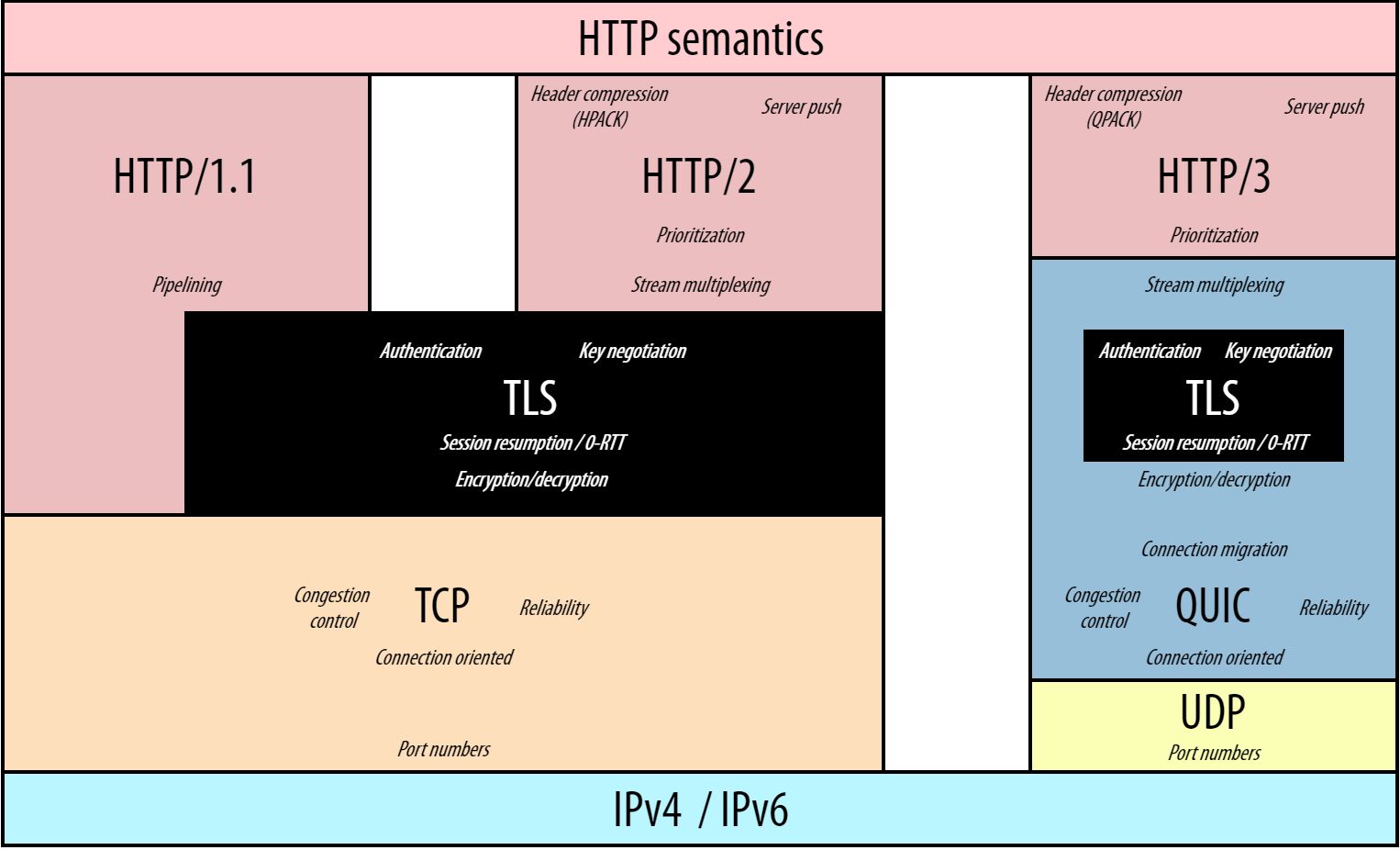
Understanding HTTP/3 Under the Hood
Let's dive into the mechanics of HTTP/3 and how it compares to HTTP/1.1 and HTTP/2.

How HTTP 1.1 Works
HTTP/1.1, the long-standing workhorse of the web, operates on a request-response model over TCP. While it introduced persistent connections and some optimizations over HTTP/1.0, it still suffers from head-of-line blocking, where the processing of multiple requests is held up by the first request in line.
How HTTP/2 Works
HTTP/2 brought significant improvements, such as multiplexing, allowing multiple requests and responses to be interleaved on a single connection. It also introduced header compression to reduce overhead and server push to preemptively send resources to the client. However, HTTP/2 still operates over TCP, which means it inherits some of TCP's inherent limitations, like head-of-line blocking at the transport layer.
HTTP/2 Cons
Despite its advancements, HTTP/2 isn't without its drawbacks:
- TCP Head-of-Line Blocking: Multiple streams in HTTP/2 are multiplexed over a single TCP connection, so if one packet is lost, all streams can be blocked until the lost packet is retransmitted.
- Underutilized Server Push: The server push feature, while innovative, has seen limited adoption and can sometimes lead to over-push, where unnecessary resources are sent to the client.
- Increased CPU Usage: The complexity of HTTP/2's multiplexing and compression can lead to higher CPU usage on servers, which can be a bottleneck for performance.
How HTTP/3 & QUIC Saves the Day
HTTP/3 introduces QUIC, a transport layer network protocol based on UDP, which aims to overcome the limitations of TCP used by HTTP/2. QUIC incorporates features like multiplexed streams without head-of-line blocking, connection migration, and reduced connection establishment time.

HTTP/3 & QUIC Pros
- Multiplexed Streams Without Head-of-Line Blocking: QUIC allows for multiple independent streams that do not suffer from TCP's head-of-line blocking, as lost packets only affect the particular stream they belong to, not the entire connection.
- Efficient Connection Establishment: QUIC combines the connection establishment and the TLS handshake into a single step, reducing latency.
- Congestion Control at Stream Level: QUIC implements congestion control for each stream, improving overall network stability and performance.
- Connection Migration: QUIC's use of connection IDs allows for connections to persist even when underlying network changes occur, such as a user switching from Wi-Fi to mobile data.
HTTP/3 & QUIC Cons
- High CPU Usage: The parsing logic required for QUIC can lead to increased CPU usage, which may impact server performance.
- UDP Blocking: Some networks block UDP traffic, which can prevent QUIC from working altogether.
- IP Fragmentation: QUIC is sensitive to IP fragmentation, which can degrade performance and reliability.
how does http/3 improve website performance
HTTP/3 significantly improves website performance in several ways:
- Reduced Head-of-Line Blocking: Unlike HTTP/2, which can experience blocking due to lost TCP packets, HTTP/3 reduces this issue by tracking packet loss on a per-stream basis, ensuring that delays in one stream do not affect others
- Enhanced Reliability: HTTP/3 is designed to be more robust to network congestion and packet loss, incorporating updated loss recovery and congestion control mechanisms. It also uses a better prioritization scheme to ensure critical data is transmitted with higher priority, even in congested network conditions
- Improved Privacy and Security: HTTP/3 includes security enhancements like TLS 1.3 and transport-level packet encryption, offering better protection for sensitive data. It also integrates protections against known denial-of-service attacks, making it more secure than previous versions
- Faster Loading Times: HTTP/3 supports faster connection setup times by combining transport and cryptographic handshakes into a single round trip, reducing latency and improving loading times compared to HTTP/2
- Multiplexing and Stream Prioritization: HTTP/3's true multiplexing nature eliminates head-of-line blocking, allowing for more efficient data transmission over the network. It incorporates stream multiplexing and per-stream flow control, enhancing performance significantly
- Compatibility and Adoption: While HTTP/3 is more complex to implement than HTTP/2 due to its use of QUIC over UDP, major browsers already support it or provide options to enable it. Enabling HTTP/3 can enhance browsing speed, security, and connections for end-users
In summary, HTTP/3 offers improved performance, reliability, security, and efficiency compared to its predecessors like HTTP/2, making it a crucial advancement for web development and user experience enhancement.
Summary
HTTP/3, powered by QUIC, represents the next step in the evolution of web protocols, offering solutions to some of the most pressing issues faced by HTTP/2, particularly around head-of-line blocking and connection efficiency. While HTTP/3 brings a host of improvements, it also introduces new challenges, such as increased CPU usage and potential issues with UDP traffic blocking. As the web continues to grow and change, HTTP/3 stands as a testament to the ongoing effort to make the internet faster, more reliable, and more efficient for users around the globe.


